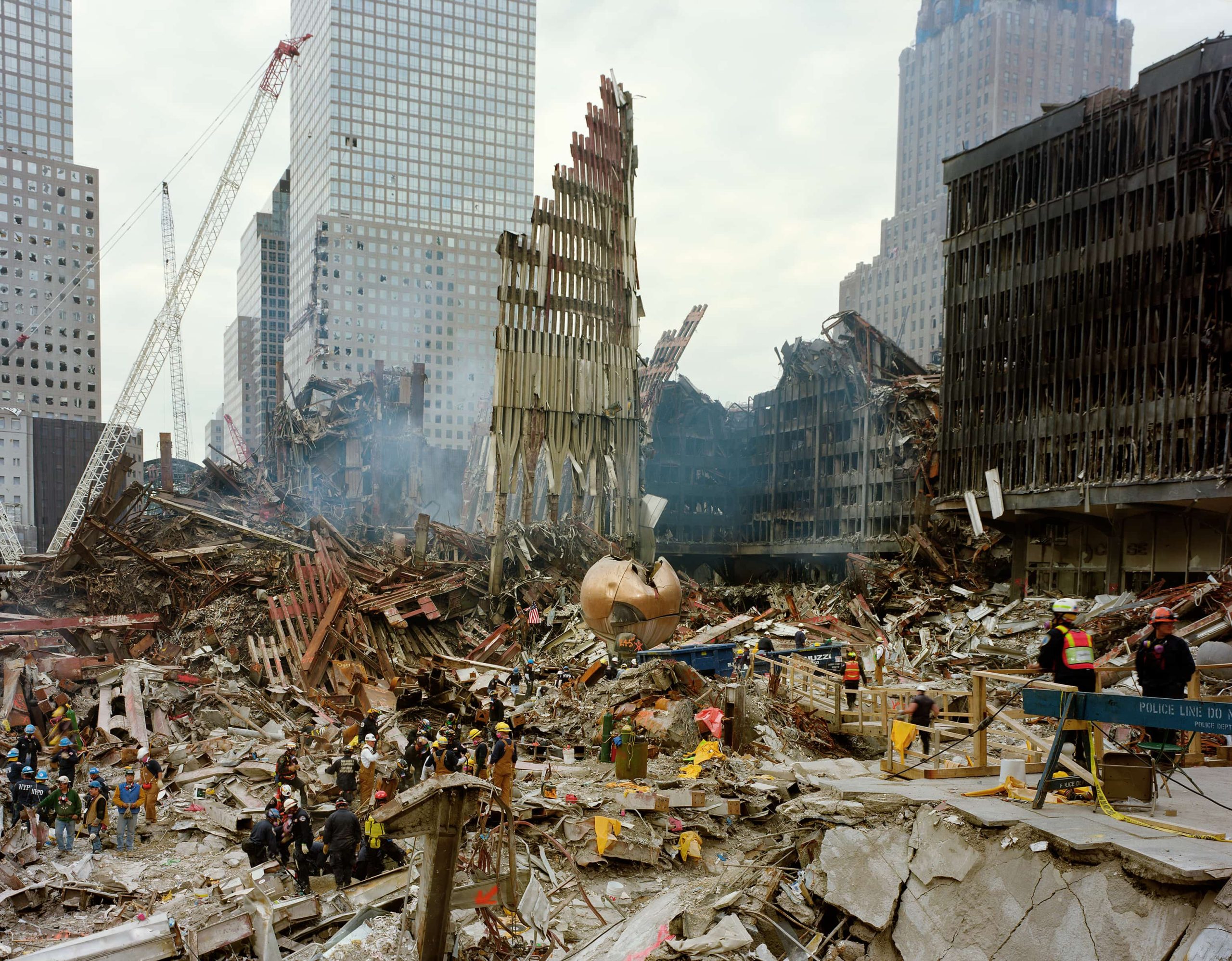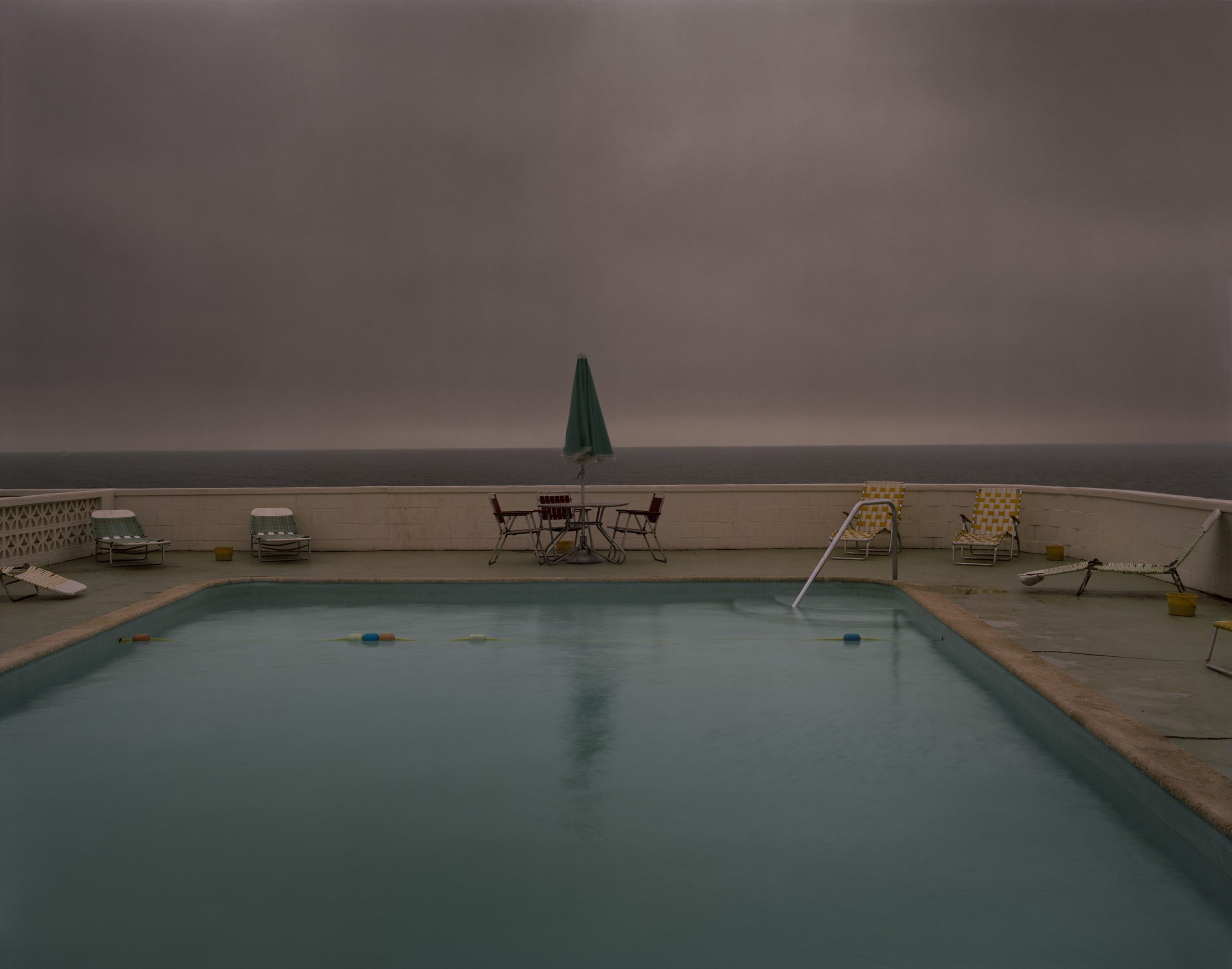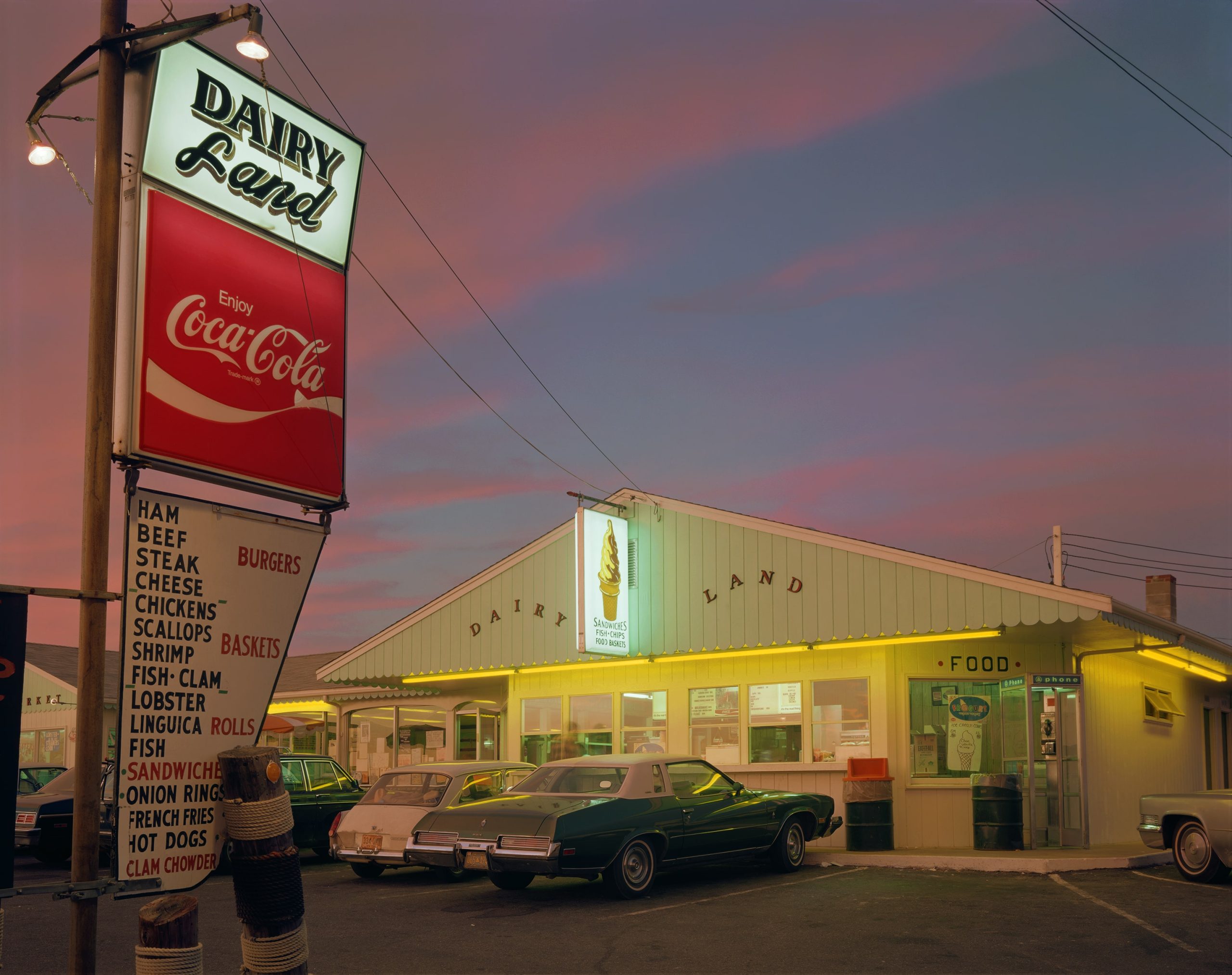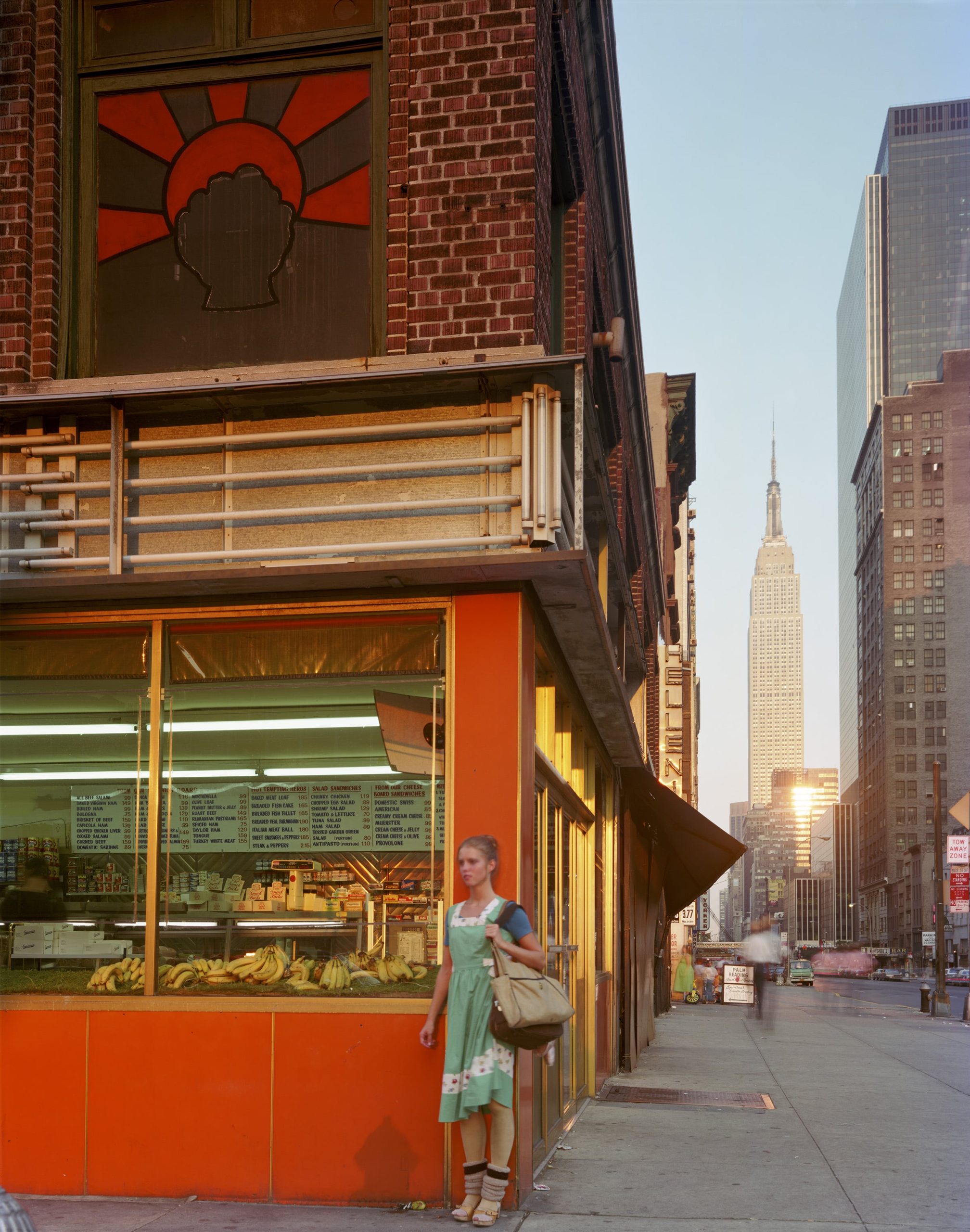Joel Meyerowitz is showing a copy of his new photo book, A Question of Color, to Present Space over Zoom. The photographer, who is calling in from his apartment in New York, received A Question of Color—“book number 53” he says—a few days prior, and has been getting used to what he describes as its intimacy. “It feels good in the hand,” he says, “something about the scale of it is right because many books are really big, and you have got to hold them in your lap to look at.” This book, meanwhile, with its paperback cover and tactile size, has been published to coincide with a display of his work at the Tate Modern in London, running from November 2023–2024
Meyerowitz is best known for his colour street photography of New York and his luminous images of Cape Cod published in his first photo book, Cape Light (1978). He was also the only photographer to gain access to Ground Zero, having managed to get a pass onto the site, despite efforts from city officials to refuse press access. That body of work, Aftermath – World Trade Center, is thus a rare, historic documentation of the excavation efforts in the nine months that followed 9/11.
Meyerowitz’s work on show at the Tate starts with his first experimentations with photography in 1962 and skips through the subsequent decades, ending with his World Trade Center series from 2002. Crucially, it explores his use of colour film over a decade before it was deemed an accepted method of photography. Up until the mid-1970s, colour photography was, as Meyerowitz recalls, seen as vulgar and commercial. For Robert Frank, the photographer who showed America itself in his pivotal photobook, The Americans (1959), “Black and white are the colors of photography. To me, they symbolize the alternatives of hope and despair to which mankind is forever subjected.”
Meyerowitz, in his colour photographs from the early 1960s onwards, wasn’t so sure— though it was Frank who inspired him to pick up a camera. As a young art director at an advertising agency, Meyerowitz designed a booklet for a job where Frank was the hired photographer and was entranced by the way he moved around, all the while taking snaps. It inspired Meyerowitz to quit his job and start photographing the streets, equipped with a camera lent to him by his now-ex-boss.


Knowing little about photography, Meyerowitz bought colour film and began photographing. In A Question of Color, the photographer outlines that these early investigations into photography, using colour, were not the work of an “art rebel”. Rather, as he says over Zoom, “I wanted to get a sense of who I was, as a young, unknown, and unknowing, photographer.” His colour photos were developed as slides, and projected onto the walls, almost as a form of entertainment. “You put them on the wall, you click, they go away, people sit in a group and they look at them, but they never got up to look closely.”
A year after Meyerowitz had first started photographing, his approach shifted after an encounter with the late street photographer, Garry Winogrand, who introduced him to black and white film, and the level of detail that it promised. From 1963, and for the next decade or so, he began carrying two 35mm cameras, one loaded with colour, the other with black and white, and would attempt to photograph the same scene twice. The result of this is what he calls “pairings”, and it is this that forms the core of A Question of Color.
Positioned side by side, Meyerowitz’s pairings, inevitably, offer up different interpretations of the same scene. As Meyerowitz writes in A Question of Color, oftentimes the colour versions of a scene felt more expressive: “They gave me more of a sense of atmosphere, or time of day, or season.” Through colour, he could capture the raw energy of the street in a way that was denied by black and white film.
Many of the images featured in A Question of Color are of the photographer’s road trip across Europe between 1966–1967. Away from the streets of New York, and the influence of other street photographers, like Winogrand, Meyerowitz was able to grapple with trying to understand what it was that he was seeking out in his images. In pairings of images from Spain, for instance, Meyerowitz captures a warmth (of the sun, but also character) that seeps through his images in a way that black and white cannot. In others, such as a roadside photograph of a couple having tea in their car in Wales, the viewer can feel the damp, foggy air in the purple hues of the sky.
By the mid-1970s, Meyerowitz had shifted his approach and began taking only colour photographs of the city with 35mm and later a large format view camera, to take in the detail and the depth of the city. “I just had this gut feeling that since the world is in colour, these colour pictures are a means to understanding oneself in the world,” he says.
Meyerowitz’s pairings remained a private project for a long time (for one, colour was expensive to print and not of the highest quality in the early days). But when Jean-Luc Monterosso, curator at the MEP in Paris, realised that his colour photography of the 1960s pushed back the chronology of colour photography’s ascent, Meyerowitz began to start displaying these pairings—A Question of Color and Tate Modern display form part of Meyerowitz’s re-investigation into some of his formative images.


It points to the simplicity of the argument in a way because the world is in colour. When you photograph in black and white, you’re seeing the graphic dynamics of something: big bus, open windows, shiny bars, people inside. You forget to think in colour. That requires an enormous mental effort because if you look around, think how hard it is to subtract colour from everything you’re seeing in an emotional sense. How do you get through all the colour vibrations coming at you to see, feel and respond in black and white? It’s part of our human capacity to suspend certain sensations to strengthen others. But once you forget about black and white and you actually look at the world, [you] begin to see the subtleties. The vapours on a humid day, the way certain things at a distance are softened, the brightness and hardness of sunlight on the side of a building—suddenly other factors come into play. Texture, tactility, sensation, space, light, all of these are an aggregate emotional input.
I feel, as a human being working in colour, that I have an opportunity to be much more expressive in terms of the information that’s coming to me. And I think what’s happened over these 60 years of working in colour, is that my sensory capacities, as the human being I am, have been expanded. Subtle things make sense to me now. I became sensitive to the incredible harmonies that were invisibly moving through the spaces that I was walking through. The world’s dimensions became richer for me.
I don’t think I was that sensitive before. I had been a painter, so I was used to putting colour on a rectangle of canvas, moving it around and trying to make it make sense to me on the canvas. But it was more formal in the sense [that] it was the period of Abstract Expressionism, and I was enthralled by the energy of that. But it was [about] making marks on a canvas; it wasn’t looking at the world. And so, when I discovered that I could make photographs while moving, and photograph moving things, having observed Robert Frank do that, I think I was enlivened by it precisely because I had been painting physically. I felt that movement, and suddenly I was seeing it on the streets of New York. The reality of everyday life became more interesting to me than standing in front of a blank canvas and pushing paint around. And I opted for life: I wanted to be out on those streets, so I quit my job, and I went out into the world to see what would happen to me.
Those pictures in the beginning are a young artist trying to figure out how to make photographs and get close to people, and really feel the otherness of human beings. And so, they’re exploratory in the sense that I needed to learn the trick of getting close to people without them turning to me and posing or acting up in some way. How could I become invisible?
By 1974 I was only using colour, but I suddenly found that I had to step back from the space I normally worked in.Garry Winogrand, Tod Papageorge and I [had been] a little trio on the street almost every day [in the 1960s]: we started shooting from about 8 feet out so that there was always a phalanx of people coming forward. That distance ideal was because black and white could trap all that space. But colour couldn’t do that—it was too slow in terms of its film speed. I found that I had to double my distance to make the pictures in colour. So, at 15 feet back, suddenly the whole field of the street was of interest rather than just people 8 feet away from me.
And so, I began to make a kind of overall picture in which incident wasn’t the hook that brought you into the picture. Now it was a non-event, and it was the whole street. And that kind of tapestry really showed me that the descriptive power of the 35mm camera, although good, didn’t have the capacity to let me make very big prints. I had been a painter and I made big canvases, so I wanted to see the street at 10 feet.
So, I wrestled with myself, and I realised that I would have to make a switch to a different format camera. That dancer on 34th Street was me trying to see if I could work with a [large format] view camera, which isn’t like a hand camera—click, click, click, click. It’s something you have to set up, focus, put a sheet of film in, take the slide out, put your head under the dark cloth. But my instinct was still that of a street photographer. I wanted to see if I could combine instinct and immediacy with the large format. The Empire State Building played the role of Mount Fuji for me; I was using Hokusai’s etchings and drawings in which he described ordinary Japanese life with the serenity of Fuji in the distance. I thought if I used the Empire State Building as Mount Fuji, then it would give me a way to make pictures of life on the street that didn’t depend upon the instantaneity of the 35mm.
I found this 8×10 view camera in Salt Lake City of all places—some guy going out of business and selling all his equipment. I knew that I couldn’t work with it in New York City to start with; I needed to really understand how to work with it, because I knew I couldn’t photograph immediacy, you know, people moving on the street. And so there I was on Cape Cod, and as I began to feel the spirit of the place, it was as if I was in a whole different language. Instead of the jazz of the street, it was like I was playing classical music really slowly and I could feel the volume.
Cape Cod is a unique place. The Cape is a sandbar 60 miles long out into the Atlantic, and when you’re on that sandbar there is no atmospheric pollution that you have on the mainland. The light was radiant in a way that I’d never experienced before. When you’re on land, all the moisture in the air has particles of dust in it; but 60 miles out to sea, the air is just air and moisture, so every molecule of moisture is like a prism. Everything seemed to be illuminated as if you were living inside the light. And that was so shocking to me. After being in the gritty corridors of Manhattan, day after day, for all those years, to be in this light chamber changed me. I started to see the most humble things in some new and extraordinary way, I can’t explain it any other way than that. Suddenly the most ordinary things took on a new kind of luminosity or presence.

I think intuition is the starting point. It brings you into contact with whatever it is that took you there, and then consciousness arrives. You’re doing work in that place, and the more you do that, the stronger your understanding of it becomes. But you only got there because you said, “That’s interesting, I’ll go there. I’ll do that. I’ll give that up to do this new thing.” It’s always a process of letting something go to move forward. I think that one of the joys of this medium for me has been that, seven or eight times in the 60 years, I’ve had these changeovers—taking a fresh look at a question that the medium itself has posed. Sometimes it means you use a new method, a bigger camera or a new subject matter. There are all kinds of interesting, thrilling, challenging, questionable things that come up and you have to resolve them.
I’m actually thinking about the series Still Life when I’m saying that because I never [used to] collect objects. I don’t know if you can see into the room in there [where Meyerowitz stores his archive], but there are thousands and thousands of photographs in there. I’m busy making those things: collecting objects was never an interest to me. But when I started living in Europe in 2012 something changed. I was living in France for a little while and working on a book on Provence, and I kept seeing these flea markets everywhere. I saw a couple of things that I bought for a friend, and when I brought them back to Italy [where Meyerowitz was living] he arrived that very same day and said, “Look what I just found.” In the back of his truck, he had a fireman’s net. It was a heavyweight canvas, but the canvas was old, it had turned sort of golden, and it had all kinds of wrinkles and marks in it. I ran inside and I got these three objects [I’d bought him] and put them on the canvas. Then he picked them up and he was holding them in his arms, and I said, “Let me see them again for a second.” I put them back on the ground, on this piece of canvas. And I said, “They look great there, don’t they? Listen, let me hold on to these for a while. And can I have that canvas too?”
For the next couple of weeks, I moved those three objects around on the canvas. [Afterwards] I went out looking for objects in the world that interested me. And bit by bit, I started to find things that spoke to me. They were crazy things, not always beautiful either. But after a while, I had assembled these things and they began to talk to each other, and to me. I assembled them in the way I saw people on the street, in clusters and relationships. Somehow, they were engaging enough that I could play with them for a few hours every day. I could move them around and just watch them. I did that for a couple of years while I was living in Italy because street life wasn’t happening out in the countryside!
It’s as if you change your location and you have new insights or inspirations. You can ride that pony because it’s fun to be on the ride. And then when it’s time to get off, you can look back and see the passage that you went through. I’m not someone who intellectualises and thinks, “Oh, I’m going to do this.” I don’t draft myself a project. Things come up out of real life and they have a calling, in a way. And if the call is strong enough to you, maybe you’ll make photographs about just the things that interest you, until they no longer do.
When I look at a photograph, I’m there. It’s as if I remember the experience, the sensation, the desire, the locale, who I was. But at the same time, I’m looking at them from the perspective of an 85-year-old person who is looking at what that 25- year-old person did. And so, I have a kind of extension of persona. I see the me that I was, and I see the me who I am, and I can see if there’s an alignment. And often there is. I recognise that those instincts that were generated by the moment back then, are still part of the essential self that I’ve become, and that alignment is incredibly satisfying. To see that I’ve grown, but I haven’t strayed far from the core.
And I think it’s relevant to all of us as human beings, as we age, to see what our path is from youth to maturity. Are we whole in some way or are we fragmented? Do we maintain certain basic principles of our essential self? Or have we completely evolved beyond that? So, it really is a trip for me because I’ve been going through box after box after box turning each picture over, looking at it, evaluating it. Some of them I’m saving, some I’m throwing away, some I’m putting in boxes for sale. But I’m also calculating and counting everything so that we know how many pictures we have in the archive, which ones have maintained their quality and which ones have failed. Colour can fail—and I’m seeing failures—and that’s to be expected because the materials were not stable back in the ‘70s, and that’s just the reality of the time. But some of them have maintained an incredible quality.
